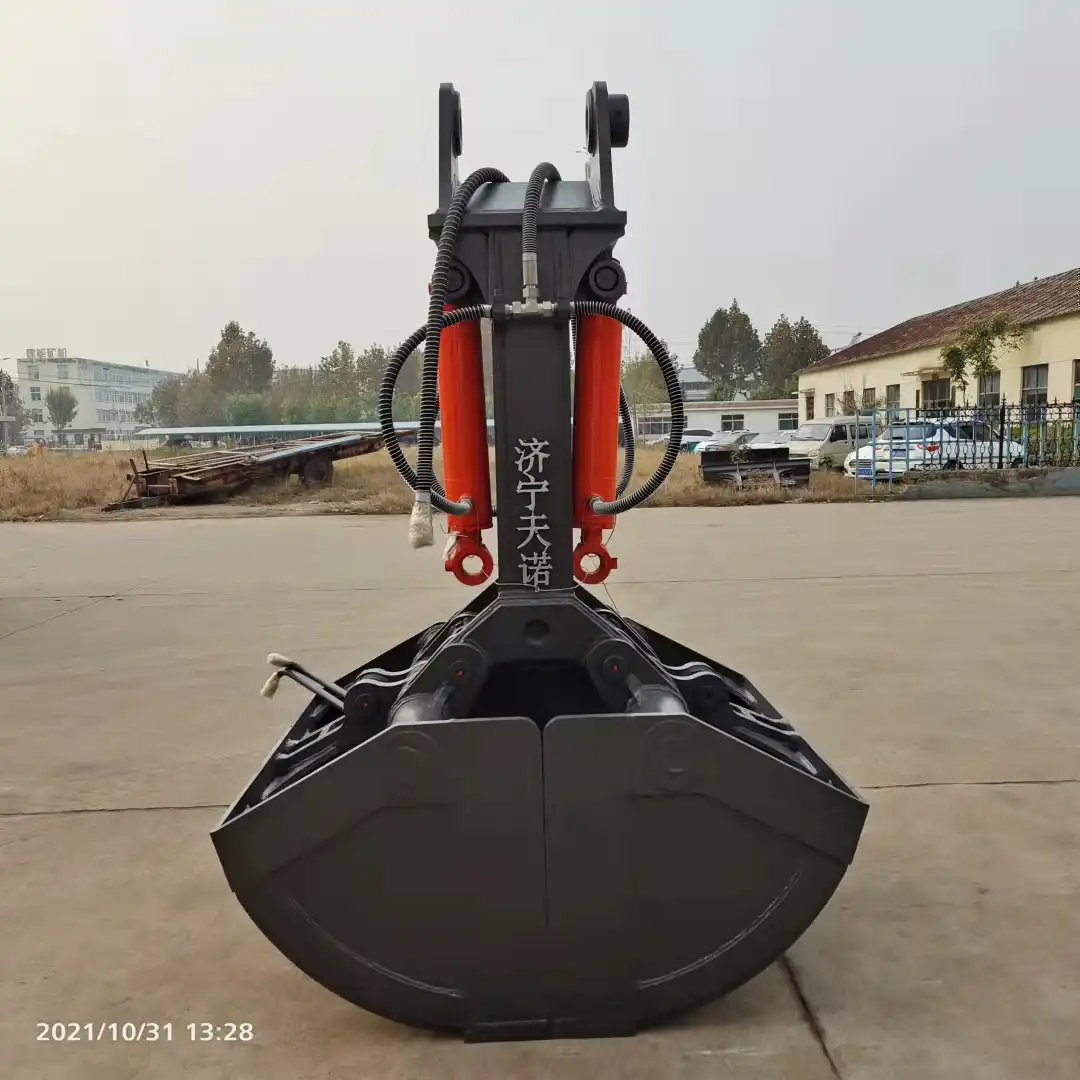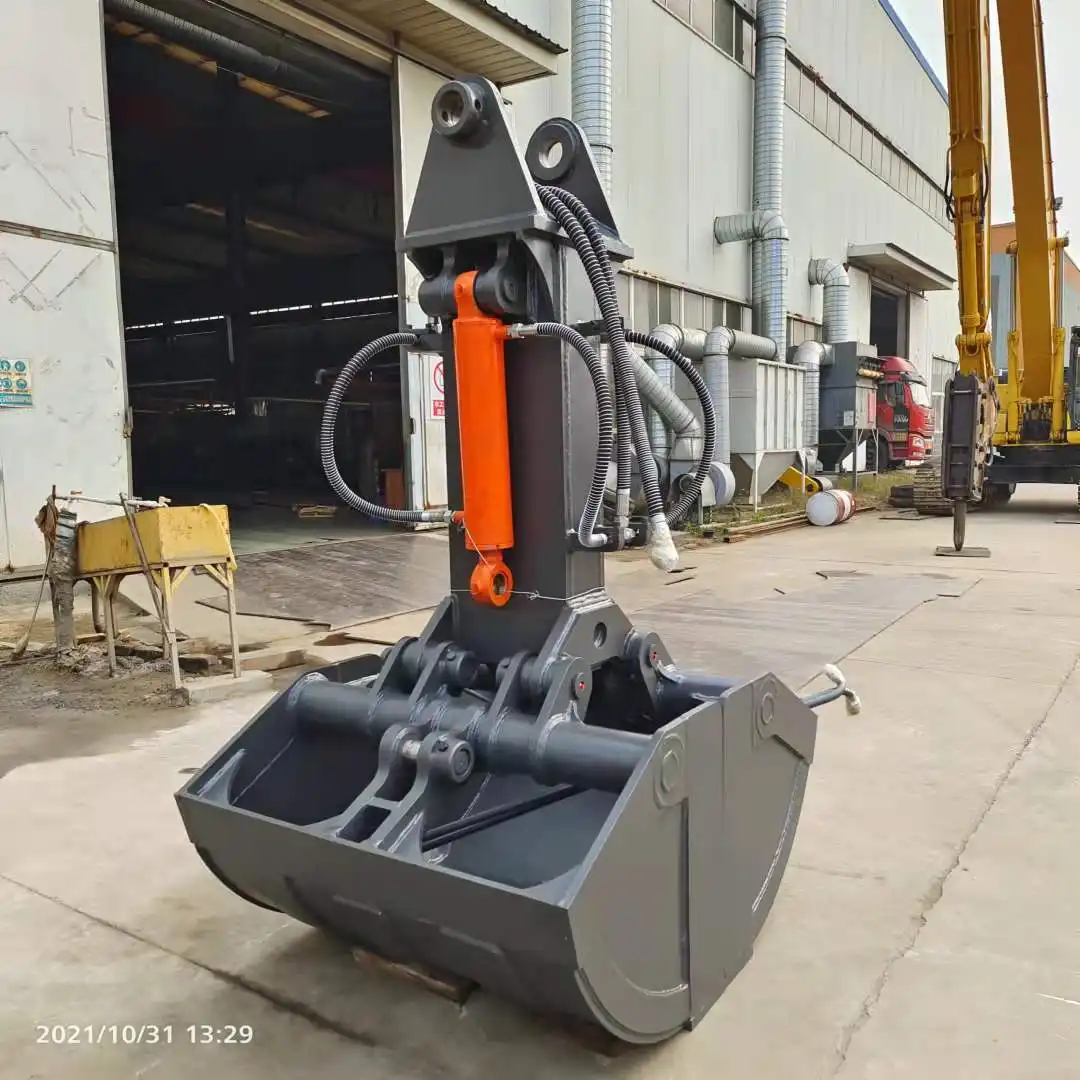Different Types of Clamshell Buckets & Advantages
There are three main types: single line, double line, and hydraulic clamshell buckets. Each type boasts unique advantages, catering to specific project needs. From railway construction to marine operations, they prove indispensable for their ability to grab, lift, and transfer materials with precision.
Single Line Clamshell
Efficient Material Handling for Excavation Projects
Single line clamshell buckets excel in excavation projects, offering a streamlined approach to material handling. These buckets operate using a single cable line, simplifying the overall mechanism and reducing maintenance needs. The simplicity of the single line system allows for quick deployment and easy operation, making it a favorite among project managers looking to boost efficiency.
In excavation scenarios, time is of the essence. Single line clamshells shine by allowing rapid cycles of digging and dumping. Their design enables operators to maintain a steady rhythm, maximizing the volume of material moved per hour. This efficiency is particularly valuable in time-sensitive projects where deadlines are tight and productivity is paramount.
Moreover, the single line configuration contributes to improved fuel efficiency. With less complex machinery involved, these buckets require less power to operate, translating to reduced fuel consumption and lower operational costs. This makes single line clamshells an attractive option for companies aiming to balance productivity with cost-effectiveness.
Ideal for Dredging and Marine Construction
When it comes to underwater operations, single line clamshell buckets prove their worth in dredging and marine construction. Their simplified design allows for easier maneuverability in aquatic environments, where visibility and control can be challenging. The single line system provides a direct and responsive connection between the operator and the bucket, enabling precise movements even in turbid waters.
Dredging projects benefit significantly from the use of single line clamshells. These buckets can efficiently scoop up sediment, debris, and other underwater materials, facilitating channel deepening, port maintenance, and environmental cleanup efforts. The buckets' ability to close tightly prevents material loss during lifting, ensuring that dredged materials are effectively removed from the water body.
In marine construction, single line clamshells play a crucial role in laying foundations and placing materials underwater. Their accuracy in grabbing and releasing materials makes them invaluable for tasks such as positioning rocks for breakwaters or placing concrete blocks for underwater structures. The simplicity of the single line system also means fewer components are exposed to corrosive saltwater, potentially extending the equipment's lifespan in marine environments.

Double Line Clamshell
Enhanced Control for Precision Digging Operations
Double line clamshell buckets take material handling to the next level, offering unparalleled control in precision digging operations. By utilizing two separate lines - one for opening and closing the bucket and another for lifting and lowering - operators gain finer control over the bucket's movements. This dual-line system allows for more nuanced manipulation, crucial when working in confined spaces or around delicate structures.
The enhanced control provided by double line clamshells is particularly beneficial in projects requiring exact excavation depths or precise material placement. For instance, in foundation work or utility trench digging, operators can maintain consistent depth and clean, straight edges. This precision not only improves the quality of work but also reduces the need for manual touch-ups, saving time and labor costs.
Additionally, the double line system excels in situations where selective material removal is necessary. In environmental remediation projects or archaeological excavations, the ability to carefully extract specific layers or objects without disturbing surrounding areas is invaluable. The bucket's controlled movements allow for gentle handling of sensitive materials, preserving their integrity throughout the extraction process.
Increased Productivity in Confined Spaces
One of the standout advantages of double line clamshell buckets is their ability to boost productivity in confined spaces. The dual-line control system allows for more precise movements, enabling operators to work effectively in tight areas where maneuverability is limited. This feature is particularly valuable in urban construction projects or renovation work where space constraints are common.
In scenarios such as basement excavations or working between existing structures, the double line clamshell's ability to dig and lift materials with minimal swing is a game-changer. Operators can execute tasks with greater efficiency, reducing the risk of collisions with surrounding obstacles and minimizing potential damage to adjacent structures.
Furthermore, the increased productivity extends to vertical operations. Double line clamshells excel in tasks like shaft sinking or working within narrow trenches. Their ability to maintain stability while digging at depth allows for faster and safer excavation in challenging vertical spaces, significantly reducing project timelines and associated costs.

Hydraulic Clamshell
Superior Gripping Power for Heavy-Duty Applications
Hydraulic clamshell buckets stand out for their exceptional gripping power, making them the go-to choice for heavy-duty applications. Unlike their cable-operated counterparts, hydraulic clamshells utilize hydraulic cylinders to open and close the bucket, resulting in significantly higher closing forces. This increased power translates to improved performance when handling dense or compacted materials that would challenge other bucket types.
In industries such as mining and demolition, where dealing with tough, abrasive materials is the norm, hydraulic clamshells shine. Their robust gripping capability allows for efficient handling of heavy rocks, concrete debris, and metal scrap. The buckets' ability to maintain a firm grip even on irregularly shaped objects enhances safety and reduces material spillage during lifting and transport operations.
Moreover, the superior gripping power of hydraulic clamshells proves invaluable in underwater applications. When working in harsh marine environments or tackling submerged demolition projects, these buckets can securely grasp and remove waterlogged materials that might slip from less powerful alternatives. This capability not only improves operational efficiency but also contributes to more thorough cleanup in underwater construction and environmental remediation efforts.
Smooth Operation for Delicate Material Handling
While known for their power, hydraulic clamshell buckets also excel in handling delicate materials with remarkable smoothness. The hydraulic system allows for precise control over the bucket's opening and closing speed, enabling operators to adjust their approach based on the material's fragility. This level of finesse is particularly valuable when working with materials that require gentle handling to maintain their integrity or value.
In recycling facilities, for instance, hydraulic clamshells prove their worth by efficiently sorting and transferring various materials without causing damage. The smooth operation allows for the careful handling of glass, electronics, and other sensitive recyclables, minimizing breakage and maintaining the quality of recovered materials. This precision not only enhances the recycling process but also contributes to higher-value end products.
The smooth operation of hydraulic clamshells also benefits agricultural and food processing industries. When handling grains, fruits, or other perishable goods, the ability to gently scoop and transfer materials without bruising or crushing is crucial. The controlled movements of hydraulic buckets help preserve product quality, reducing waste and maintaining the value of harvested crops throughout the handling process.
Adaptable Design for Multiple Excavator Models
One of the key advantages of hydraulic clamshell buckets is their adaptable design, allowing for compatibility with a wide range of excavator models. This versatility stems from the buckets' modular construction and standardized hydraulic connections, which can be tailored to fit various machine specifications. As a result, construction companies and equipment rental firms can maximize their investment by using these attachments across different excavators in their fleet.
The adaptability extends beyond mere fitment. Hydraulic clamshells can be customized with different jaw designs, capacities, and hydraulic flow requirements to match specific project needs and excavator capabilities. This flexibility allows operators to optimize performance for tasks ranging from light-duty sorting to heavy-duty demolition, all with the same base attachment.
Furthermore, the adaptable nature of hydraulic clamshells facilitates easy upgrades and maintenance. As excavator technology evolves, these buckets can often be modified or updated to work with newer machine models, extending their operational life and providing long-term value. This adaptability not only enhances equipment utilization but also contributes to more sustainable construction practices by reducing the need for frequent attachment replacements.
Whether you opt for the simplicity of single line models, the precision of double line systems, or the power of hydraulic clamshells, these attachments significantly enhance project outcomes. By carefully considering your specific needs and operational environment, you can select the ideal clamshell bucket to boost productivity, reduce costs, and improve safety on your job sites.
FAQs
Q1: What's the main difference between single line and double line clamshell buckets?
A1: Single line clamshell buckets operate using one cable for both opening/closing and lifting/lowering, offering simplicity and cost-effectiveness. Double line buckets use separate lines for these functions, providing enhanced control and precision in material handling.
Q2: Are hydraulic clamshell buckets more efficient than cable-operated ones?
A2: Hydraulic clamshell buckets generally offer higher gripping power and more precise control, making them more efficient for heavy-duty tasks and delicate material handling. However, cable-operated buckets may be preferred in certain scenarios due to their simplicity and lower maintenance requirements.
Q3: Can clamshell buckets be used for underwater operations?
A3: Yes, clamshell buckets, especially single line and hydraulic types, are well-suited for underwater operations such as dredging, marine construction, and underwater excavation. Their design allows for effective material grabbing and retention even in submerged conditions.
Q4: How do I choose the right clamshell bucket for my project?
A4: Consider factors such as the type of material you'll be handling, required precision, operational environment (land or underwater), and your excavator's specifications. Single line buckets are great for general use, double line for precision work, and hydraulic for heavy-duty applications.
Q5: What maintenance is required for clamshell buckets?
A5: Regular maintenance includes inspecting for wear and damage, lubricating moving parts, checking hydraulic systems (for hydraulic models), and ensuring proper alignment of cables (for cable-operated models). Follow the manufacturer's guidelines for specific maintenance schedules and procedures.
China Clamshell Bucket Supplier
TianNuo Machinery stands out as a leading manufacturer in China, offering a comprehensive range of high-quality excavator attachments. Our product line extends beyond clamshell buckets to include various railway maintenance equipment, excavator modification solutions, and specialized engineering arms. We pride ourselves on delivering products that meet the highest standards of durability and performance, catering to the diverse needs of the construction, mining, and transportation industries. For those seeking reliable excavator accessories, we invite you to explore our offerings and contact us at tn@stnd-machinery.com for personalized solutions tailored to your specific project requirements.
References
- Smith, J. (2023). "Advanced Techniques in Material Handling: The Role of Clamshell Buckets." Construction Equipment Guide, 15(4), 78-85.
- Johnson, L. & Brown, M. (2022). "Comparative Analysis of Clamshell Bucket Types in Marine Construction." International Dredging Review, 41(2), 112-120.
- TianNuo Machinery. (2023). "Clamshell Bucket Specifications and Applications." TianNuo Machinery Official Website.
- Zhang, Y. et al. (2021). "Efficiency Improvements in Excavation: A Study on Hydraulic Clamshell Buckets." Journal of Construction Engineering, 37(3), 301-315.
- Wilson, R. (2023). "Innovations in Clamshell Bucket Design for Mining Operations." Excavator Magazine, 29(6), 42-50.
- Heavy Equipment Forums. (2023). "User Experiences with Different Clamshell Bucket Types." Online Discussion Thread, accessed September 2023.
About Author: Arm
Arm is a leading expert in the field of specialized construction and railway maintenance equipment, working at Tiannuo Company.

